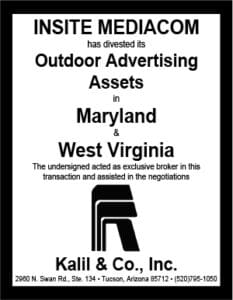
Billboard Insider recently reported on how four operators joined forces to impact the January 6th amendment to the Clovis, New Mexico Sign Code. These operators, namely Lindmark, Choice Media, Fluhman Media, and Clovis Sign & Service, lead a grass roots efforts with the local business community, which along with some old fashion attorney sword clanging, resulted in productive conversations with the City’s attorney and other leaders, and the eventual compromises leading to this “pared-down” sign code amendment. Ryan Zaloudik of Lindmark was quoted in the Insider article as characterizing the amendment in a Mick Jagger-like fashion as “very rarely do you get exactly what you want,” but sometimes like this you get what you need, including “saving a costly legal fight, a great success, and a win!” Indeed, this legal, political, and negotiation success is a good model on how to influence a sign code amendment.
Successful influence on any type of legislation begins long before any amendments are proposed, by first becoming involved in the local community and political process. Brannon New of Clovis Sign & Service, for example, has been an active member of the Clovis Chamber of Commerce, which was effectively enlisted as an ally in promoting the interests of the local sign industry throughout the couple of years the amendment was debated. Similarly, whether running for political office, or volunteering as a little league coach, active participation in local community activities enhances the credibility of anyone seeking to influence a sign code amendment whenever it is eventually proposed.
Once the idea is raised of amending the sign code, legal and pollical efforts should be quickly mobilized. In about 2019, Clovis joined many municipalities across the country to assess its sign regulations in light of the Supreme Court’s 2015 decision in Reed vs Town of Gilbert, holding that content-based sign codes violated the Free Speech Clause of the First Amendment. While the Clovis Commissioners examined the constitutional implications of its regulations, detractors of the sign industry attempted to exploit the attention by proposing draconian revisions to the Code, such as imposing amortization schemes, retroactive compliance, and elimination of nonconforming status. Thus, it became critical to secure a thorough legal analysis of the proposal, which my clients fortunately sought from me early in the process.
My clients, by the way, deserve a lot of credit in this cooperative effort. They came together quickly to reach out to their local contacts, share similar experiences, and of course, divide attorneys fees. I believe there is definitely political and legal advantages when representing a group of competitors, rather than an individual operator, in this type of sign code challenge.
The analysis of the amendments advocated by the usual suspects, in turn, identified a laundry list of constitutionally suspect provisions. After consulting with the clients, and determining their practicalities and priorities, I drafted a demand letter to the Clovis City Attorney. This correspondence, like most in my experience, needs to convey in uncertain terms the legal challenges that will be aggressively pursued in litigation and otherwise, should the illegal amendments be passed and enforced. On the other hand, this initial contact with the opposing counsel is also the opportunity to seek reasonable compromise, by proposing constitutional alternatives to the code language. As I explained to my clients, they will almost always be more satisfied with a compromised amendment to the sign code they can live with, as opposed to the uncertainty and expense associated with protracted litigation with the government.
As expected, the City Attorney responded defensively, albeit cordially, to the allegations and demands contained in my letter. At this stage, it became obvious that more candid negotiations, rather that the usual attorney saber rattling or the initiation of litigation, would facilitate productive compromise and consideration of alternative code language. And, since I was likely perceived as the out-of-state billboard expert lawyer, my clients and I decided to engage local legal counsel to help break through this barrier of suspicion and distrust. Clovis attorney Randy Knudson, who had broad litigation experience, although not with billboards, proved to be the perfect ally. On top of his effective advocacy, Randy had a personal relationship with the Clovis City Attorney, which rendered him credible in their more casual discussions and exchanges of several proposals. These efforts culminated in a draft of the sign code amendment provided by the Clovis City Attorney that my clients found fair, reasonable, and legal.
Special credit goes to Brannon, who relied on long standing relationships with customers, landowners, and other stakeholders, in persuading them to vocally support the proposal amendment at successive Commission meetings and in letters to their Commissioners. All of these cooperative efforts eventually resulted in a unanimous vote approving the amendment to the Clovis Sign Code. Thus, a victory could be justifiably declared by both the City, which implemented a constitutionally compliant and content-neutral sign code, and the local billboard operators, who secured reasonable and predictable regulations, all without the expense, uncertainty, and acrimony of litigation.
[wpforms id=”9787″]
Paid Advertisement

















